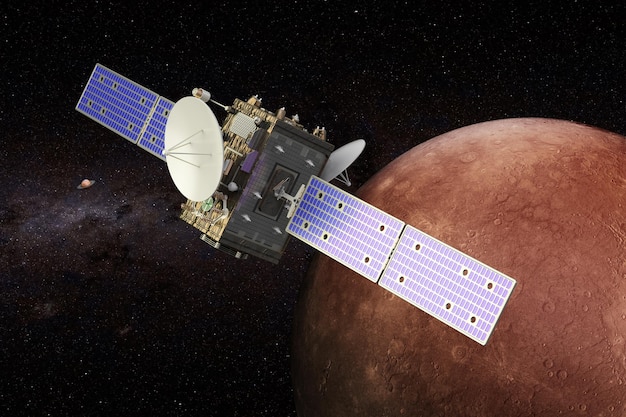US Space Policy: Goals and Priorities for the Next Decade

US Space Policy in the next decade focuses on advancing space exploration, enhancing national security, promoting commercial space activities, and fostering international cooperation, driving innovation and ensuring American leadership in space.
The **US Space Policy: What Are the Goals and Priorities for the Next Decade?** is a multifaceted strategy designed to maintain and enhance America’s leadership in space. This involves not only advancing scientific knowledge and exploration, but also addressing critical issues such as national security, commercial opportunities, and international collaboration.
Understanding the Foundations of US Space Policy
US Space Policy serves as the guiding framework for the nation’s activities in space. It encompasses a wide range of objectives, from scientific research and exploration to national security and economic development. Understanding its foundations is crucial for grasping the direction and potential impact of future endeavors.
Historical Context and Evolution
The history of US Space Policy is marked by significant milestones, reflecting evolving priorities and technological advancements. From the Cold War-era space race to the post-Cold War focus on collaboration and commercialization, US Space Policy has adapted to meet new challenges and opportunities.
Key historical moments include:
- The establishment of NASA in 1958, which centralized civilian space activities.
- The Apollo program in the 1960s, which demonstrated American technological prowess and national ambition.
- The development of the Space Shuttle program, which aimed to provide routine access to space.
- The rise of commercial space companies in the 21st century, which has transformed the landscape of space activities.
Key Legislative and Executive Actions
US Space Policy is shaped by a combination of legislative actions and executive directives. Congress plays a vital role in authorizing funding and setting broad policy goals, while the President issues executive orders and policy directives to guide the implementation of these goals.
Examples of key legislative and executive actions include:
- The National Aeronautics and Space Act of 1958, which established NASA and defined its mission.
- The Commercial Space Launch Act of 1984, which facilitated the development of the commercial space industry.
- Presidential directives on space policy, which have addressed issues such as space exploration, national security, and international cooperation.
In conclusion, Understanding the foundations of US Space Policy is a great way to gain perspective on what is to come in the future.

National Security Objectives in Space
Space has become an increasingly critical domain for national security, with a growing reliance on space-based assets for communication, navigation, surveillance, and missile warning. Protecting these assets and ensuring their continued availability is a top priority for US Space Policy.
Protecting US Space Assets
The US relies on a vast network of satellites for a wide range of functions, including military operations, intelligence gathering, and civilian services. Protecting these assets from attack or disruption is essential for maintaining national security.
Deterrence and Defense Strategies
US Space Policy emphasizes deterrence and defense strategies to discourage potential adversaries from attacking US space assets. This includes developing capabilities to detect, track, and respond to threats in space.
Key strategies include:
- Developing resilient and redundant space systems that can withstand attack or disruption.
- Enhancing space situational awareness to detect and track potential threats.
- Maintaining offensive capabilities to deter aggression in space.
International Cooperation on Space Security
The US also seeks to promote international cooperation on space security issues, working with allies and partners to develop norms of behavior and promote responsible use of space.
US Space Policy has expanded over the years to include not just national security, but international cooperation to try to make space available for everyone.
Advancing Space Exploration and Scientific Discovery
Space exploration and scientific discovery are core pillars of US Space Policy. These activities not only expand our understanding of the universe but also inspire innovation, drive technological advancements, and create economic opportunities.

Missions to the Moon and Mars
The US is currently pursuing ambitious missions to the Moon and Mars, with the goal of establishing a sustained human presence on both celestial bodies. These missions are designed to address fundamental scientific questions, test new technologies, and prepare for future exploration of the solar system.
Exploring Beyond the Solar System
US Space Policy also supports missions to explore beyond the solar system, seeking to understand the origins of the universe, search for extraterrestrial life, and study distant galaxies and exoplanets.
Investing in Space Science and Research
The US invests heavily in space science and research, supporting a wide range of activities from ground-based telescopes to space-based observatories. These investments have yielded groundbreaking discoveries in fields such as astronomy, astrophysics, planetary science, and Earth science.
In addition to other pursuits, space exploration continues to be a high-priority and important endeavor for many.
Promoting Commercial Space Activities
The commercial space industry has experienced tremendous growth in recent years, driven by innovation, investment, and government policies that promote private sector involvement in space activities. US Space Policy seeks to further accelerate this growth, fostering a vibrant and competitive commercial space sector.
Incentivizing Private Sector Innovation
US Space Policy encourages private sector innovation through a variety of mechanisms, including:
- Providing funding for research and development.
- Offering incentives for commercial space activities.
- Reducing regulatory barriers to entry.
Supporting Commercial Space Transportation
Commercial space transportation has become a critical component of the US space program, enabling the delivery of cargo and crew to the International Space Station (ISS) and other destinations. US Space Policy supports the continued development of commercial space transportation capabilities.
Examples of commercial space transportation companies include:
- SpaceX
- Blue Origin
- Virgin Galactic
Expanding Commercial Opportunities in Space
US Space Policy seeks to expand commercial opportunities in space, promoting activities such as:
- Space tourism
- Space manufacturing
- Space resource utilization
The commercial space industry has come a long way, from mere concepts to actual products.
Fostering International Cooperation in Space
Space is a global commons, and international cooperation is essential for ensuring its peaceful and sustainable use. US Space Policy recognizes the importance of working with allies and partners to address shared challenges and opportunities in space.
Collaborative Missions and Projects
The US engages in numerous collaborative missions and projects with other countries, including:
- The International Space Station (ISS)
- Joint Earth observation missions
- Collaborative space exploration initiatives
Sharing Data and Expertise
The US shares data and expertise with other countries to promote scientific discovery, improve space situational awareness, and enhance space security.
Establishing Norms of Behavior in Space
The US works with other countries to establish norms of behavior in space, promoting responsible use of space and preventing the escalation of conflict in space.
When different countries come together, the level of creativity and possibility is greatly increased.
Addressing Challenges and Future Directions
US Space Policy faces a number of challenges in the coming decade, including:
Funding and Budgetary Constraints
Securing adequate funding for space activities is a constant challenge, particularly in an era of competing priorities and budgetary constraints. US Space Policy must prioritize investments in areas that offer the greatest return on investment.
Technological Advancements and Disruptions
Rapid technological advancements and disruptions are transforming the space industry, creating both opportunities and challenges. US Space Policy must adapt to these changes and ensure that the US remains at the forefront of innovation.
Geopolitical Competition in Space
Geopolitical competition in space is intensifying, with countries such as China and Russia seeking to challenge US leadership in space. US Space Policy must address these challenges and maintain America’s competitive edge.
All of these challenges must be overcome in US Space Policy to move forward with successful future endeavors.
| Key Point | Brief Description |
|---|---|
| 🚀 Space Exploration | Focus on missions to the Moon and Mars. |
| 🛰️ National Security | Protecting US assets and deterring threats. |
| 💰 Commercial Space | Promoting private sector involvement and innovation. |
| 🤝 International Collab | Cooperation for space security and exploration. |
Frequently Asked Questions
▼
The main goal is to maintain US leadership in space, driving scientific discovery, economic growth, and ensuring national security.
▼
It prioritizes protecting US space assets from attack and developing strategies to deter aggression in space, ensuring reliable space-based capabilities.
▼
Commercial space activities are actively promoted, encouraging private sector innovation and expanding opportunities in space-based industries.
▼
International cooperation is essential for the peaceful and sustainable use of space, sharing data, and establishing responsible norms of behavior in space.
▼
Challenges include funding constraints, adapting to technological disruptions, and addressing geopolitical competition in space to maintain US leadership.
Conclusion
In summary, **US Space Policy: What Are the Goals and Priorities for the Next Decade?** will continue to evolve, driven by technological advancements, geopolitical dynamics, and the ever-present human desire to explore the unknown. By addressing these challenges and pursuing its ambitious goals, the US can maintain its leadership in space and ensure that space activities benefit all of humankind.





